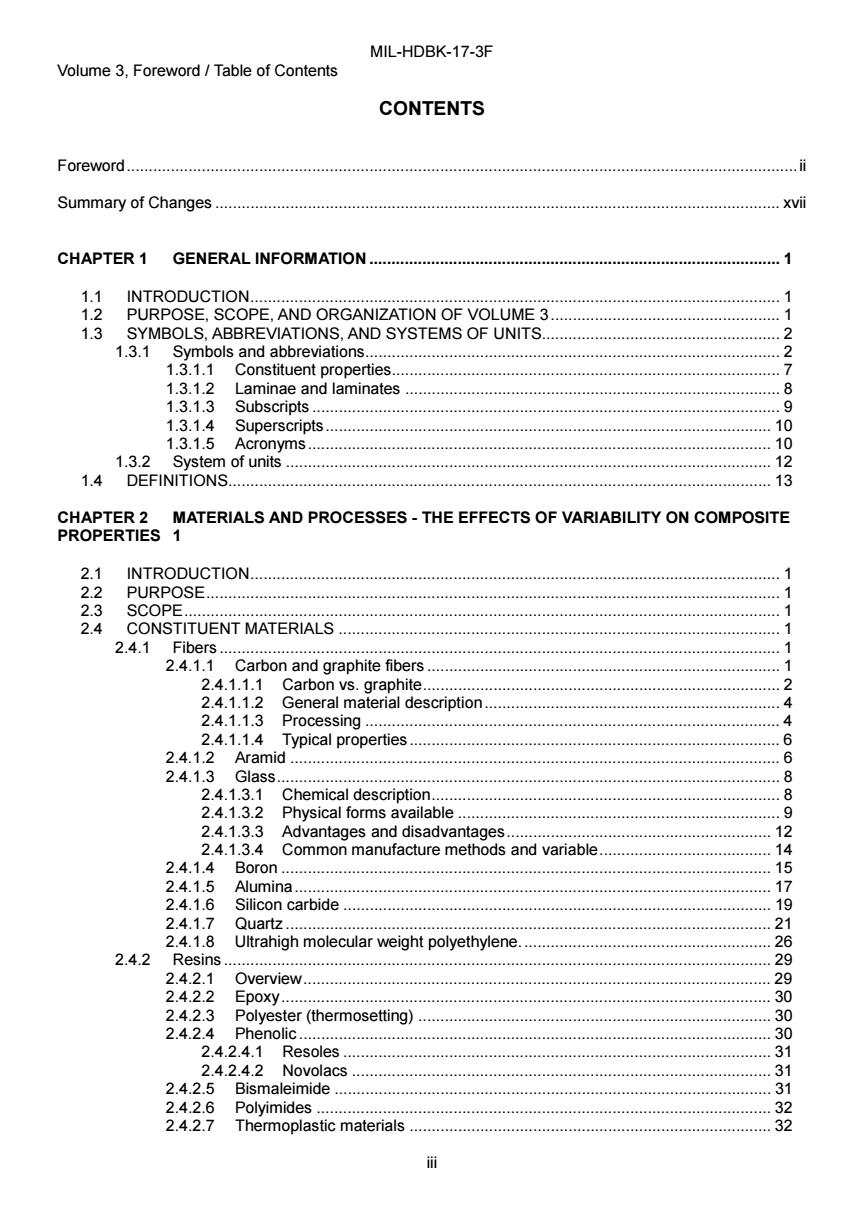
MIL-HDBK-17-3F Volume 3,Foreword Table of Contents CONTENTS Foreword Summary of Changes.… .xvii CHAPTER 1 GENERAL INFORMATION....... 1 1.1 NTRODUCTON 1.2 PURPOSE,SCOPE,AND ORGANIZATION OF VOLUME 3. 1 1.3 SYMBOLS,ABBREVIATIONS,AND SYSTEMS OF UNITS. .2 1.3.1 Symbols and abbreviations............... 2 1.3.1.1 Constituent properties... 1.3.1.2 Laminae and laminates. 8 1.3.1.3 Subscripts........ 9 1.3.1.4 Superscripts.... 10 1.3.1.5 Acronyms.… 10 1.3.2 System of units.... 12 1.4 DEFINITIONS........ 13 CHAPTER 2 MATERIALS AND PROCESSES-THE EFFECTS OF VARIABILITY ON COMPOSITE PROPERTIES 2.1 INTRODUCTION........ 1 2.2 PURPOSE 44444404444404 1 2.3 SCOPE... 1 2.4 CONSTITUENT MATERIALS 1 2.4.1 Fibers... 2.4.1.1 Carbon and graphite fibers............. 1 2.4.1.1.1 Carbon vs.graphite...... 2 2.4.1.1.2 General material description. .4 2.4.1.1.3 Processing.… 4 2.4.1.1.4 Typical properties.. ,6 2.4.1.2 Aramid..... 6 2.4.1.3 Glass 8 2.4.1.3.1 Chemical description.... 8 2.4.1.3.2 Physical forms available......... 9 2.4.1.3.3 Advantages and disadvantages................ 12 2.4.1.3.4 Common manufacture methods and variable..... 14 2.4.1.4 Bopon.... 15 2.4.1.5 Alumina.... 17 2.4.1.6 Silicon carbide. 19 2.4.1.7 Quartz......... 21 2.4.1.8 Ultrahigh molecular weight polyethylene. 26 2.4.2 29 RSl门S.................... 2.4.2.1 Overview..… 29 2.4.2.2 Epoxy.... 30 2.4.2.3 Polyester(thermosetting) 30 2.4.2.4 Phenolic....... 2.4.2.4.1 Resoles..... 3 2.4.2.4.2 NoV0aCs… 31 2.4.2.5 Bismaleimide................... 31 2.4.2.6 Polyimides............ 32 2.4.2.7 Thermoplastic materials 3 分
MIL-HDBK-17-3F Volume 3, Foreword / Table of Contents iii CONTENTS Foreword........................................................................................................................................................ii Summary of Changes ................................................................................................................................ xvii CHAPTER 1 GENERAL INFORMATION ............................................................................................. 1 1.1 INTRODUCTION........................................................................................................................ 1 1.2 PURPOSE, SCOPE, AND ORGANIZATION OF VOLUME 3.................................................... 1 1.3 SYMBOLS, ABBREVIATIONS, AND SYSTEMS OF UNITS...................................................... 2 1.3.1 Symbols and abbreviations.............................................................................................. 2 1.3.1.1 Constituent properties........................................................................................ 7 1.3.1.2 Laminae and laminates ..................................................................................... 8 1.3.1.3 Subscripts .......................................................................................................... 9 1.3.1.4 Superscripts..................................................................................................... 10 1.3.1.5 Acronyms......................................................................................................... 10 1.3.2 System of units .............................................................................................................. 12 1.4 DEFINITIONS........................................................................................................................... 13 CHAPTER 2 MATERIALS AND PROCESSES - THE EFFECTS OF VARIABILITY ON COMPOSITE PROPERTIES 1 2.1 INTRODUCTION........................................................................................................................ 1 2.2 PURPOSE.................................................................................................................................. 1 2.3 SCOPE....................................................................................................................................... 1 2.4 CONSTITUENT MATERIALS .................................................................................................... 1 2.4.1 Fibers ............................................................................................................................... 1 2.4.1.1 Carbon and graphite fibers ................................................................................ 1 2.4.1.1.1 Carbon vs. graphite................................................................................. 2 2.4.1.1.2 General material description................................................................... 4 2.4.1.1.3 Processing .............................................................................................. 4 2.4.1.1.4 Typical properties.................................................................................... 6 2.4.1.2 Aramid ............................................................................................................... 6 2.4.1.3 Glass.................................................................................................................. 8 2.4.1.3.1 Chemical description............................................................................... 8 2.4.1.3.2 Physical forms available ......................................................................... 9 2.4.1.3.3 Advantages and disadvantages............................................................ 12 2.4.1.3.4 Common manufacture methods and variable....................................... 14 2.4.1.4 Boron ............................................................................................................... 15 2.4.1.5 Alumina............................................................................................................ 17 2.4.1.6 Silicon carbide ................................................................................................. 19 2.4.1.7 Quartz .............................................................................................................. 21 2.4.1.8 Ultrahigh molecular weight polyethylene......................................................... 26 2.4.2 Resins ............................................................................................................................ 29 2.4.2.1 Overview.......................................................................................................... 29 2.4.2.2 Epoxy............................................................................................................... 30 2.4.2.3 Polyester (thermosetting) ................................................................................ 30 2.4.2.4 Phenolic ........................................................................................................... 30 2.4.2.4.1 Resoles ................................................................................................. 31 2.4.2.4.2 Novolacs ............................................................................................... 31 2.4.2.5 Bismaleimide ................................................................................................... 31 2.4.2.6 Polyimides ....................................................................................................... 32 2.4.2.7 Thermoplastic materials .................................................................................. 32
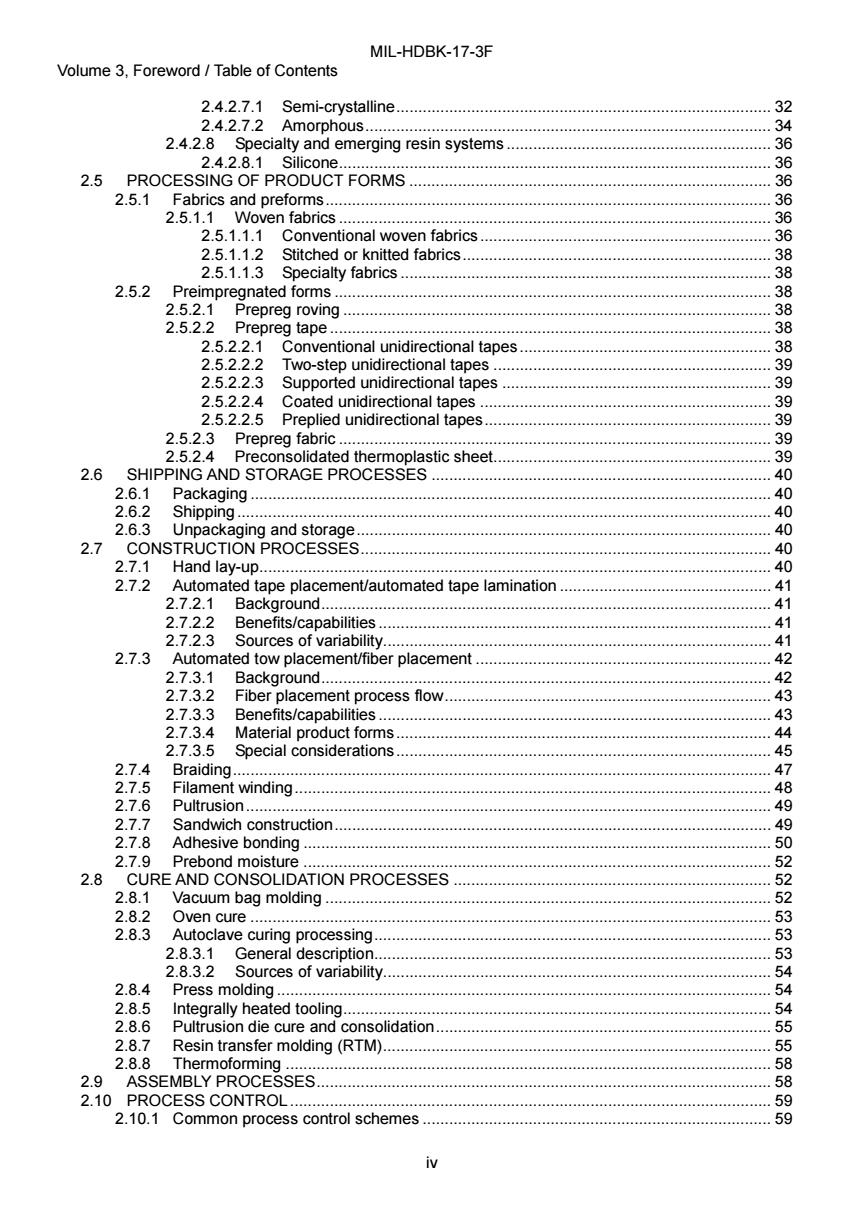
MIL-HDBK-17-3F Volume 3.Foreword Table of Contents 2.4.2.7.1 Semi-crystalline..... ,32 2.4.2.7.2 Amorphous........... 34 2.4.2.8 Specialty and emerging resin systems.......... .36 2.4.2.8.1 Silicone... 36 2.5 PROCESSING OF PRODUCT FORMS.................... 36 2.5.1 Fabrics and preforms..36 2.5.1.1 Woven fabrics... 6 2.5.1.1.1 Conventional woven fabrics.. 36 25.1.1.2 Stitched or knitted fabrics....... 38 2.5.1.1.3 Specialty fabrics..38 2.5.2 Preimpregnated forms.38 2.5.2.1 Prepreg roving… 8 2.5.2.2 Prepreg tape.......... 38 2.5.2.2.1 Conventional unidirectional tapes....................38 2.5.2.2.2 Two-step unidirectional tapes............... .39 2.5.2.2.3 Supported unidirectional tapes.39 2.5.2.2.4 Coated unidirectional tapes.... 39 2.5.2.2.5 Preplied unidirectional tapes. 39 2.5.2.3 Prepreg fabric. 39 2.5.2.4 Preconsolidated thermoplastic sheet..... 39 26 SHIPPING AND STORAGE PROCESSES.................................................. 40 2.6.1 Packaging.… 40 2.6.2 Shipping....... 40 2.6.3 Unpackaging and storage........ 40 2.7 CONSTRUCTION PROCESSES 40 2.7.1 Hand lay-up. 40 2.7.2 Automated tape placement/automated tape lamination.... 41 2.7.2.1 Background....... 41 2.7.2.2 Benefits/capabilities. 41 2.7.2.3 Sources of variability........ 41 2.7.3 Automated tow placement/fiber placement.......................... 42 2.7.3.1 Background..... 42 2.7.3.2 Fiber placement process flow................. 43 2.7.3.3 Benefits/capabilities... 43 2.7.3.4 Material product forms. 44 2.7.3.5 Special considerations 2.7.4 2.7.5 Braiding. > Filament winding..... 48 2.7.6 Pultrusion............... 49 2.7.7 Sandwich construction........ 49 2.7.8 Adhesive bonding.. 50 2.7.9 Prebond moisture ......... 52 2.8 CURE AND CONSOLIDATION PROCESSES ..52 2.8.1 Vacuum bag molding...52 2.8.2 Oven cure.… 53 2.8.3 Autoclave curing processing................ 53 2.8.3.1 General description.. 53 2.8.3.2 Sources of variability............ 54 2.8.4 Press molding 54 2.8.5 Integrally heated tooling........ 54 2.8.6 Pultrusion die cure and consolidation..... 55 2.8.7 Resin transfer molding (RTM)..................... 55 2.8.8 Thermoforming.... 58 2.9 ASSEMBLY PROCESSES..... 58 2.10 PROCESS CONTROL............ 59 2.10.1 Common process control schemes............. 59 iv
MIL-HDBK-17-3F Volume 3, Foreword / Table of Contents iv 2.4.2.7.1 Semi-crystalline..................................................................................... 32 2.4.2.7.2 Amorphous............................................................................................ 34 2.4.2.8 Specialty and emerging resin systems ............................................................ 36 2.4.2.8.1 Silicone.................................................................................................. 36 2.5 PROCESSING OF PRODUCT FORMS .................................................................................. 36 2.5.1 Fabrics and preforms..................................................................................................... 36 2.5.1.1 Woven fabrics .................................................................................................. 36 2.5.1.1.1 Conventional woven fabrics.................................................................. 36 2.5.1.1.2 Stitched or knitted fabrics...................................................................... 38 2.5.1.1.3 Specialty fabrics .................................................................................... 38 2.5.2 Preimpregnated forms ................................................................................................... 38 2.5.2.1 Prepreg roving ................................................................................................. 38 2.5.2.2 Prepreg tape .................................................................................................... 38 2.5.2.2.1 Conventional unidirectional tapes......................................................... 38 2.5.2.2.2 Two-step unidirectional tapes ............................................................... 39 2.5.2.2.3 Supported unidirectional tapes ............................................................. 39 2.5.2.2.4 Coated unidirectional tapes .................................................................. 39 2.5.2.2.5 Preplied unidirectional tapes................................................................. 39 2.5.2.3 Prepreg fabric .................................................................................................. 39 2.5.2.4 Preconsolidated thermoplastic sheet............................................................... 39 2.6 SHIPPING AND STORAGE PROCESSES ............................................................................. 40 2.6.1 Packaging ...................................................................................................................... 40 2.6.2 Shipping......................................................................................................................... 40 2.6.3 Unpackaging and storage.............................................................................................. 40 2.7 CONSTRUCTION PROCESSES............................................................................................. 40 2.7.1 Hand lay-up.................................................................................................................... 40 2.7.2 Automated tape placement/automated tape lamination ................................................ 41 2.7.2.1 Background...................................................................................................... 41 2.7.2.2 Benefits/capabilities ......................................................................................... 41 2.7.2.3 Sources of variability........................................................................................ 41 2.7.3 Automated tow placement/fiber placement ................................................................... 42 2.7.3.1 Background...................................................................................................... 42 2.7.3.2 Fiber placement process flow.......................................................................... 43 2.7.3.3 Benefits/capabilities ......................................................................................... 43 2.7.3.4 Material product forms..................................................................................... 44 2.7.3.5 Special considerations..................................................................................... 45 2.7.4 Braiding.......................................................................................................................... 47 2.7.5 Filament winding............................................................................................................ 48 2.7.6 Pultrusion....................................................................................................................... 49 2.7.7 Sandwich construction................................................................................................... 49 2.7.8 Adhesive bonding .......................................................................................................... 50 2.7.9 Prebond moisture .......................................................................................................... 52 2.8 CURE AND CONSOLIDATION PROCESSES ........................................................................ 52 2.8.1 Vacuum bag molding ..................................................................................................... 52 2.8.2 Oven cure ...................................................................................................................... 53 2.8.3 Autoclave curing processing.......................................................................................... 53 2.8.3.1 General description.......................................................................................... 53 2.8.3.2 Sources of variability........................................................................................ 54 2.8.4 Press molding ................................................................................................................ 54 2.8.5 Integrally heated tooling................................................................................................. 54 2.8.6 Pultrusion die cure and consolidation............................................................................ 55 2.8.7 Resin transfer molding (RTM)........................................................................................ 55 2.8.8 Thermoforming .............................................................................................................. 58 2.9 ASSEMBLY PROCESSES....................................................................................................... 58 2.10 PROCESS CONTROL ............................................................................................................. 59 2.10.1 Common process control schemes ............................................................................... 59
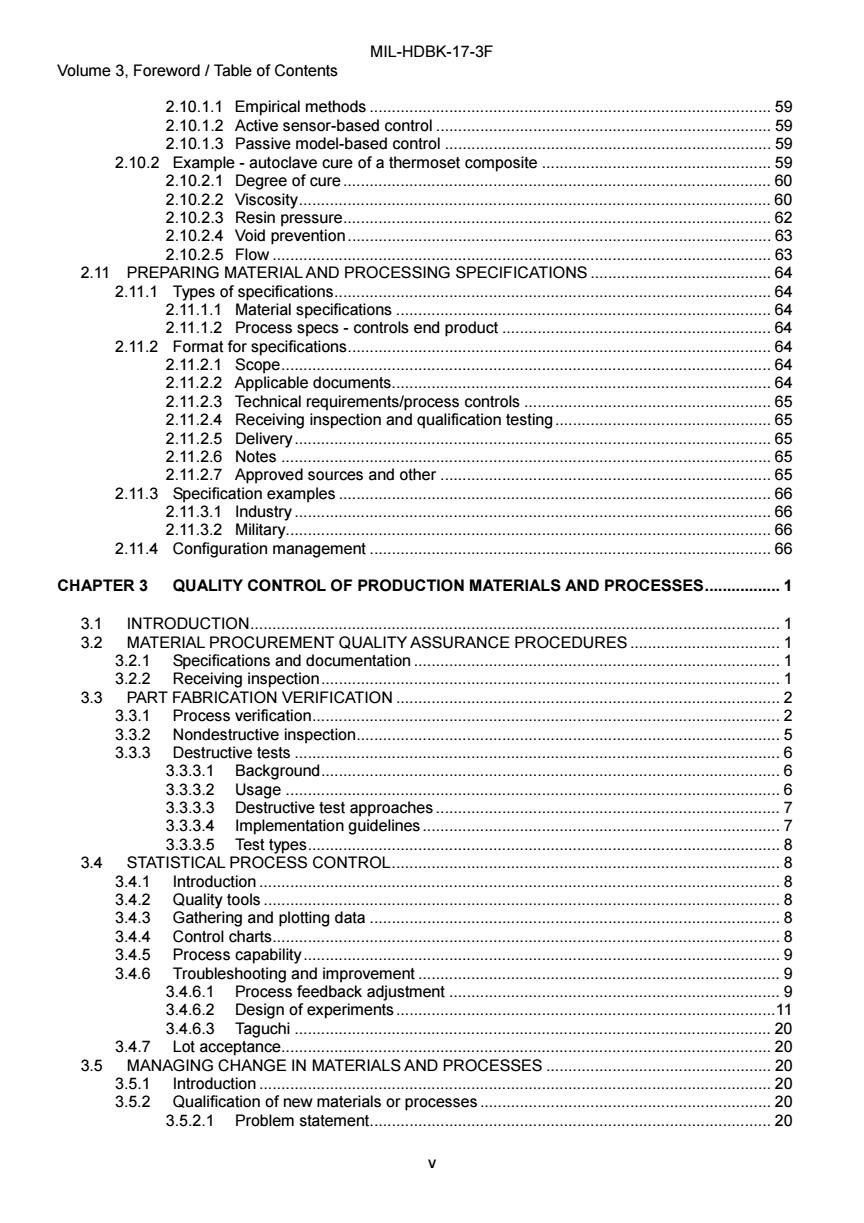
MIL-HDBK-17-3F Volume 3.Foreword Table of Contents 2.10.1.1 Empirical methods... 2.10.1.2 Active sensor-based control................... 59 59 2.10.1.3 Passive model-based control.59 2.10.2 Example-autoclave cure of a thermoset composite............ 59 2.10.2.1 Degree of cure............... 60 2.10.22 VSCOSity..60 2.10.2.3 Resin pressure............ .62 2.10.2.4 Void prevention. 63 2.10.2.5Flow. 63 2.11 PREPARING MATERIAL AND PROCESSING SPECIFICATIONS......................................6.4 2.11.1 Types of specifications.........64 2.11.1.1 Material specifications... 4 2.11.1.2 Process specs controls end product.. 64 2.11.2 Format for specifications.................. .64 2.11.2.1Sc0pe.… .64 2.11.2.2 Applicable documents........... 2.11.2.3 Technical requirements/process controls...... .64 65 2.11.2.4 Receiving inspection and qualification testing........................................... 65 2.11.2.5 Delivery.65 2.11.2.6 Notes.… .65 2.11.2.7 Approved sources and other..65 2.11.3 Specification examples ... .66 2.11.3.1 Industry.… 66 2.11.3.2 Military....... .66 2.11.4 Configuration management....... .66 CHAPTER 3 QUALITY CONTROL OF PRODUCTION MATERIALS AND PROCESSES.................1 3.1 INTRODUCTION................. .1 3.2 MATERIAL PROCUREMENT QUALITY ASSURANCE PROCEDURES................................1. 3.2.1 Specifications and documentation.............. 1 3.2.2 Receiving inspection. 3.3 PART FABRICATION VERIFICATION... ,2 3.3.1 Process verification.................. 2 3.3.2 Nondestructive inspection. 3.3.3 Destructive tests.… .6 3.3.3.1 Background6 3.3.3.2 Usage .. 3.3.3.3 Destructive test approaches.... 7 3.3.3.4 Implementation guidelines.... .7 3.3.3.5 Test types... 8 3.4 STATISTICAL PROCESS CONTROL. .8 3.4.1 Introduction.… 3.4.2 .8 Quality tools. .8 3.4.3 Gathering and plotting data................. .8 3.4.4 Control charts..... 3.4.5 Process capability....... .8 9 3.4.6 Troubleshooting and improvement....... 3.4.6.1 Process feedback adjustment........ …9 9 3.4.6.2 Design of experiments1 3.4.6.3 Taguchi..... 20 3.4.7 Lot acceptance...... 20 3.5 MANAGING CHANGE IN MATERIALS AND PROCESSES................................. 20 3.5.1 Introduction............. .20 3.5.2 Qualification of new materials or processes....... 20 3.5.2.1 Problem statement.... .20
MIL-HDBK-17-3F Volume 3, Foreword / Table of Contents v 2.10.1.1 Empirical methods ........................................................................................... 59 2.10.1.2 Active sensor-based control ............................................................................ 59 2.10.1.3 Passive model-based control .......................................................................... 59 2.10.2 Example - autoclave cure of a thermoset composite .................................................... 59 2.10.2.1 Degree of cure................................................................................................. 60 2.10.2.2 Viscosity........................................................................................................... 60 2.10.2.3 Resin pressure................................................................................................. 62 2.10.2.4 Void prevention................................................................................................ 63 2.10.2.5 Flow ................................................................................................................. 63 2.11 PREPARING MATERIAL AND PROCESSING SPECIFICATIONS ......................................... 64 2.11.1 Types of specifications................................................................................................... 64 2.11.1.1 Material specifications ..................................................................................... 64 2.11.1.2 Process specs - controls end product ............................................................. 64 2.11.2 Format for specifications................................................................................................ 64 2.11.2.1 Scope............................................................................................................... 64 2.11.2.2 Applicable documents...................................................................................... 64 2.11.2.3 Technical requirements/process controls ........................................................ 65 2.11.2.4 Receiving inspection and qualification testing................................................. 65 2.11.2.5 Delivery............................................................................................................ 65 2.11.2.6 Notes ............................................................................................................... 65 2.11.2.7 Approved sources and other ........................................................................... 65 2.11.3 Specification examples .................................................................................................. 66 2.11.3.1 Industry ............................................................................................................ 66 2.11.3.2 Military.............................................................................................................. 66 2.11.4 Configuration management ........................................................................................... 66 CHAPTER 3 QUALITY CONTROL OF PRODUCTION MATERIALS AND PROCESSES................. 1 3.1 INTRODUCTION........................................................................................................................ 1 3.2 MATERIAL PROCUREMENT QUALITY ASSURANCE PROCEDURES .................................. 1 3.2.1 Specifications and documentation ................................................................................... 1 3.2.2 Receiving inspection........................................................................................................ 1 3.3 PART FABRICATION VERIFICATION ....................................................................................... 2 3.3.1 Process verification.......................................................................................................... 2 3.3.2 Nondestructive inspection................................................................................................ 5 3.3.3 Destructive tests .............................................................................................................. 6 3.3.3.1 Background........................................................................................................ 6 3.3.3.2 Usage ................................................................................................................ 6 3.3.3.3 Destructive test approaches .............................................................................. 7 3.3.3.4 Implementation guidelines................................................................................. 7 3.3.3.5 Test types........................................................................................................... 8 3.4 STATISTICAL PROCESS CONTROL........................................................................................ 8 3.4.1 Introduction ...................................................................................................................... 8 3.4.2 Quality tools ..................................................................................................................... 8 3.4.3 Gathering and plotting data ............................................................................................. 8 3.4.4 Control charts................................................................................................................... 8 3.4.5 Process capability............................................................................................................ 9 3.4.6 Troubleshooting and improvement .................................................................................. 9 3.4.6.1 Process feedback adjustment ........................................................................... 9 3.4.6.2 Design of experiments......................................................................................11 3.4.6.3 Taguchi ............................................................................................................ 20 3.4.7 Lot acceptance............................................................................................................... 20 3.5 MANAGING CHANGE IN MATERIALS AND PROCESSES ................................................... 20 3.5.1 Introduction .................................................................................................................... 20 3.5.2 Qualification of new materials or processes.................................................................. 20 3.5.2.1 Problem statement........................................................................................... 20
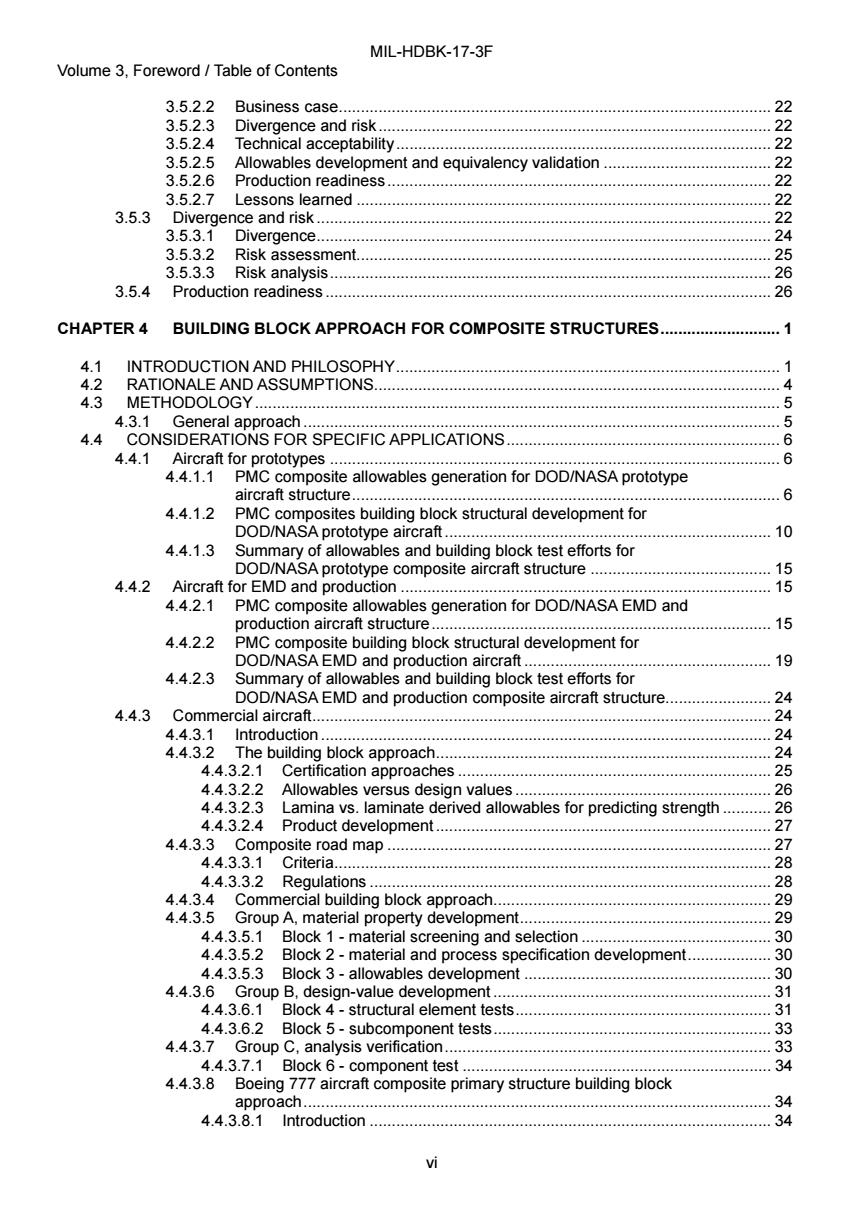
MIL-HDBK-17-3F Volume 3.Foreword Table of Contents 3.5.2.2 Business case.... 22 3.5.2.3 Divergence and risk... 22 3.5.2.4 Technical acceptability22 3.5.2.5 Allowables development and equivalency validation ........................... 22 3.5.2.6 Production readiness................... 22 3.5.2.7 Less0 ns learned… 22 3.5.3 Divergence and risk............. 22 3.5.3.1 Divergence.......... 24 3.5.3.2 Risk assessment............... 25 3.5.3.3 Risk analysis.. 4.4...... 26 3.5.4 Production readiness...... 26 CHAPTER 4 BUILDING BLOCK APPROACH FOR COMPOSITE STRUCTURES.... 1 4.1 INTRODUCTION AND PHILOSOPHY.......... 1 4.2 RATIONALE AND ASSUMPTIONS................... 4 4.3 METHODOLOGY.......... .5 4.3.1 General approach... 5 4.4 CONSIDERATIONS FOR SPECIFIC APPLICATIONS.......................................... 6 4.4.1 Aircraft for prototypes ................ 0.6 4.4.1.1 PMC composite allowables generation for DOD/NASA prototype aircraft structure....... .6 4.4.1.2 PMC composites building block structural development for DOD/NASA prototype aircraft........ 10 4.4.1.3 Summary of allowables and building block test efforts for DOD/NASA prototype composite aircraft structure................15 4.4.2 Aircraft for EMD and production...... .15 4.4.2.1 PMC composite allowables generation for DOD/NASA EMD and production aircraft structure.. 15 4.4.2.2 PMC composite building block structural development for DOD/NASA EMD and production aircraft.......... .19 4.4.2.3 Summary of allowables and building block test efforts for DOD/NASA EMD and production composite aircraft structure.................4 4.4.3 Commercial aircraft................ 24 4.4.3.1 Introduction… 24 4.4.3.2 The building block approach....24 4.4.3.2.1 certification approaches................. .25 4.4.3.2.2 Allowables versus design values..... 26 4.4.3.23 Lamina vs.laminate derived allowables for predicting strength...........26 4.4.3.2.4 Product development27 4.4.3.3 Composite road map......... 27 4.4.3.3.1 Criteria.… 28 4.4.3.3.2 Regulations.… 28 4.4.3.4 Commercial building block approach..29 4.4.3.5 Group A,material property development...... .29 4.4.3.5.1 Block 1-material screening and selection..... 30 4.4.3.5.2 Block 2-material and process specification development................... 30 4.4.3.5.3 Block 3-allowables development ,30 4.4.3.6 Group B,design-value development...........31 4.4.3.6.1 Block 4-structural element tests.......................31 4.4.3.6.2 Block 5-subcomponent tests. 33 4.4.3.7 Group C,analysis verification... 33 4.4.3.7.1 Block 6-component test.34 4.4.3.8 Boeing 777 aircraft composite primary structure building block approach. 34 4.4.3.8.1 Introduction................ 34
MIL-HDBK-17-3F Volume 3, Foreword / Table of Contents vi 3.5.2.2 Business case.................................................................................................. 22 3.5.2.3 Divergence and risk......................................................................................... 22 3.5.2.4 Technical acceptability..................................................................................... 22 3.5.2.5 Allowables development and equivalency validation ...................................... 22 3.5.2.6 Production readiness....................................................................................... 22 3.5.2.7 Lessons learned .............................................................................................. 22 3.5.3 Divergence and risk ....................................................................................................... 22 3.5.3.1 Divergence....................................................................................................... 24 3.5.3.2 Risk assessment.............................................................................................. 25 3.5.3.3 Risk analysis.................................................................................................... 26 3.5.4 Production readiness..................................................................................................... 26 CHAPTER 4 BUILDING BLOCK APPROACH FOR COMPOSITE STRUCTURES........................... 1 4.1 INTRODUCTION AND PHILOSOPHY....................................................................................... 1 4.2 RATIONALE AND ASSUMPTIONS............................................................................................ 4 4.3 METHODOLOGY....................................................................................................................... 5 4.3.1 General approach ............................................................................................................ 5 4.4 CONSIDERATIONS FOR SPECIFIC APPLICATIONS.............................................................. 6 4.4.1 Aircraft for prototypes ...................................................................................................... 6 4.4.1.1 PMC composite allowables generation for DOD/NASA prototype aircraft structure................................................................................................. 6 4.4.1.2 PMC composites building block structural development for DOD/NASA prototype aircraft .......................................................................... 10 4.4.1.3 Summary of allowables and building block test efforts for DOD/NASA prototype composite aircraft structure ......................................... 15 4.4.2 Aircraft for EMD and production .................................................................................... 15 4.4.2.1 PMC composite allowables generation for DOD/NASA EMD and production aircraft structure............................................................................. 15 4.4.2.2 PMC composite building block structural development for DOD/NASA EMD and production aircraft ........................................................ 19 4.4.2.3 Summary of allowables and building block test efforts for DOD/NASA EMD and production composite aircraft structure........................ 24 4.4.3 Commercial aircraft........................................................................................................ 24 4.4.3.1 Introduction ...................................................................................................... 24 4.4.3.2 The building block approach............................................................................ 24 4.4.3.2.1 Certification approaches ....................................................................... 25 4.4.3.2.2 Allowables versus design values .......................................................... 26 4.4.3.2.3 Lamina vs. laminate derived allowables for predicting strength ........... 26 4.4.3.2.4 Product development ............................................................................ 27 4.4.3.3 Composite road map ....................................................................................... 27 4.4.3.3.1 Criteria................................................................................................... 28 4.4.3.3.2 Regulations ........................................................................................... 28 4.4.3.4 Commercial building block approach............................................................... 29 4.4.3.5 Group A, material property development......................................................... 29 4.4.3.5.1 Block 1 - material screening and selection ........................................... 30 4.4.3.5.2 Block 2 - material and process specification development................... 30 4.4.3.5.3 Block 3 - allowables development ........................................................ 30 4.4.3.6 Group B, design-value development ............................................................... 31 4.4.3.6.1 Block 4 - structural element tests.......................................................... 31 4.4.3.6.2 Block 5 - subcomponent tests............................................................... 33 4.4.3.7 Group C, analysis verification.......................................................................... 33 4.4.3.7.1 Block 6 - component test ...................................................................... 34 4.4.3.8 Boeing 777 aircraft composite primary structure building block approach.......................................................................................................... 34 4.4.3.8.1 Introduction ........................................................................................... 34
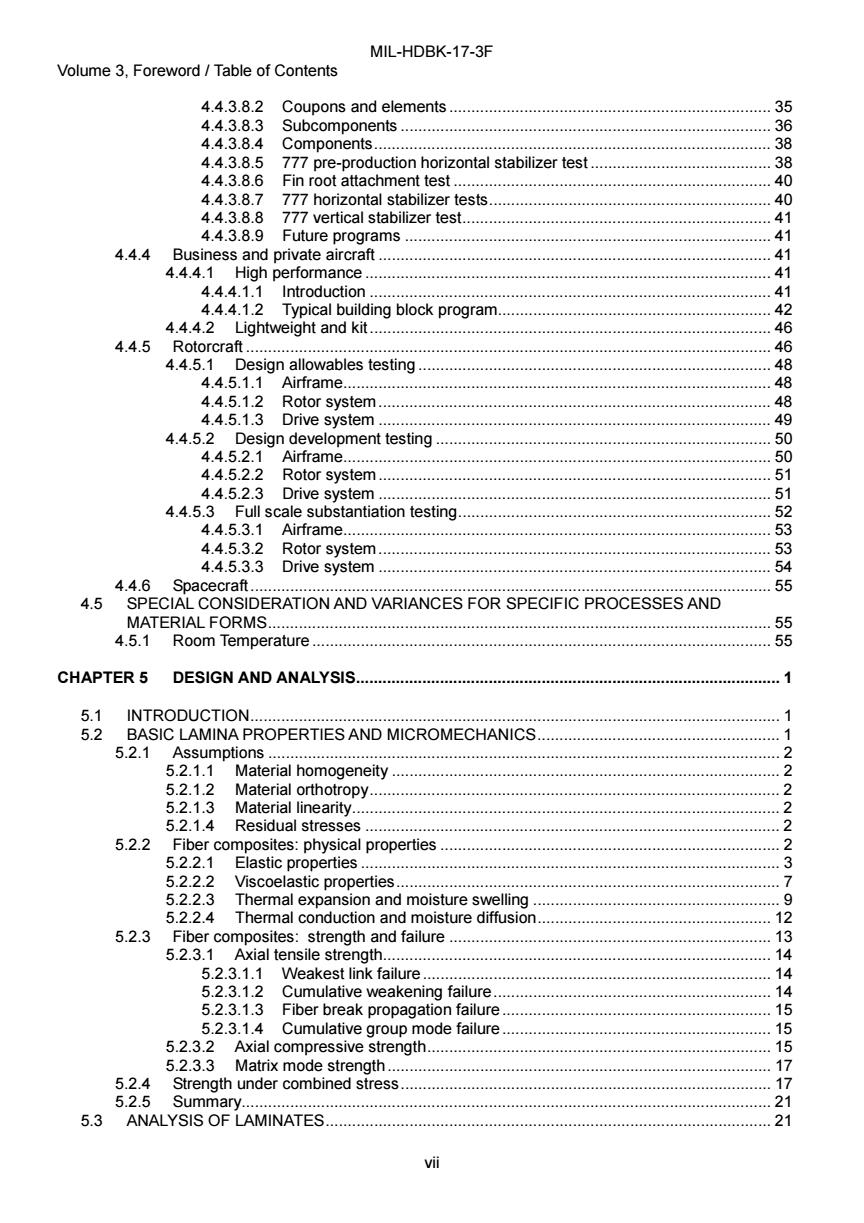
MIL-HDBK-17-3F Volume 3.Foreword Table of Contents 4.4.3.8.2 Coupons and elements........ 4.4.3.8.3 Subcomponents.… 35 36 4.4.3.8.4 Components... 38 4.4.3.8.5 777 pre-production horizontal stabilizer test................................. 38 4.4.3.86 Fin root attachment test................. 40 4.4.3.8.7 777 horizontal stabilizer tests..40 4.4.3.8.8 777 vertical stabilizer test............. 41 4.4.3.8.9 Future programs. 41 4.4.4 Business and private aircraft............... 41 4.4.4.1 High performance.... .41 4.4.4.1.1 Introduction... 41 4.4.4.1.2 Typical building block program.... 4 4.4.4.2 Lightweight and kit. 46 46 4.4.5 Rotorcratt............................................................................................. 4.4.5.1 Design allowables testing.............. 48 4.4.5.1.1 Airframe...48 4.4.5.1.2 Rotor system..... 48 4.4.5.1.3 Drive system ....................... 49 4.4.5.2 Design development testing. ,50 4.4.5.2.1 Airframe.............. .50 4.4.5.2.2 Rotor SyStem....51 4.4.5.2.3 Drive system... 51 4.4.5.3 Full scale substantiation testing.... 52 4.4.5.3.1 Airframe..… .53 4.4.5.3.2 Rotor system.................... 53 4.4.5.3.3 Drive system. 54 4.4.6 Spacecraft.… .55 4.5 SPECIAL CONSIDERATION AND VARIANCES FOR SPECIFIC PROCESSES AND MATERIAL FORMS...........................55 4.5.1 Room Temperature................... .55 CHAPTER 5 DESIGN AND ANALYSIS.... 1 5.1 INTRODUCTION........ .1 5.2 BASIC LAMINA PROPERTIES AND MICROMECHANICS... 5.2.1 Assumptions .............. 2 5.2.1.1 Material homogeneity 5.2.1.2 Material orthotropy........... 5.2.1.3 Material linearity................... 2 5.2.1.4 Residual stresses............................. 5.2.2 Fiber composites:physical properties...... 2 2 5.2.2.1 Elastic properties... 5.2.2.2 > Viscoelastic properties.. 5.2.2.3 Thermal expansion and moisture swelling.........................................9 5.2.2.4 Thermal conduction and moisture diffusion..... 12 5.2.3 Fiber composites:strength and failure......... .13 5.2.3.1 Axial tensile strength.................................... 14 5.2.3.1.1 Weakest link failure14 5.2.3.1.2 Cumulative weakening failure.............. .14 5.2.3.1.3 Fiber break propagation failure...............................15 5.2.3.1.4 Cumulative group mode failure. 15 5.2.3.2 Axial compressive strength............................ 15 5.2.3.3 Matrix mode strength.. 17 5.2.4 Strength under combined stress...................... …17 5.2.5 Summary21 5.3 ANALYSIS OF LAMINATES........ .21 vii
MIL-HDBK-17-3F Volume 3, Foreword / Table of Contents vii 4.4.3.8.2 Coupons and elements ......................................................................... 35 4.4.3.8.3 Subcomponents .................................................................................... 36 4.4.3.8.4 Components.......................................................................................... 38 4.4.3.8.5 777 pre-production horizontal stabilizer test ......................................... 38 4.4.3.8.6 Fin root attachment test ........................................................................ 40 4.4.3.8.7 777 horizontal stabilizer tests................................................................ 40 4.4.3.8.8 777 vertical stabilizer test...................................................................... 41 4.4.3.8.9 Future programs ................................................................................... 41 4.4.4 Business and private aircraft ......................................................................................... 41 4.4.4.1 High performance ............................................................................................ 41 4.4.4.1.1 Introduction ........................................................................................... 41 4.4.4.1.2 Typical building block program.............................................................. 42 4.4.4.2 Lightweight and kit........................................................................................... 46 4.4.5 Rotorcraft ....................................................................................................................... 46 4.4.5.1 Design allowables testing ................................................................................ 48 4.4.5.1.1 Airframe................................................................................................. 48 4.4.5.1.2 Rotor system......................................................................................... 48 4.4.5.1.3 Drive system ......................................................................................... 49 4.4.5.2 Design development testing ............................................................................ 50 4.4.5.2.1 Airframe................................................................................................. 50 4.4.5.2.2 Rotor system......................................................................................... 51 4.4.5.2.3 Drive system ......................................................................................... 51 4.4.5.3 Full scale substantiation testing....................................................................... 52 4.4.5.3.1 Airframe................................................................................................. 53 4.4.5.3.2 Rotor system......................................................................................... 53 4.4.5.3.3 Drive system ......................................................................................... 54 4.4.6 Spacecraft...................................................................................................................... 55 4.5 SPECIAL CONSIDERATION AND VARIANCES FOR SPECIFIC PROCESSES AND MATERIAL FORMS.................................................................................................................. 55 4.5.1 Room Temperature ........................................................................................................ 55 CHAPTER 5 DESIGN AND ANALYSIS................................................................................................ 1 5.1 INTRODUCTION........................................................................................................................ 1 5.2 BASIC LAMINA PROPERTIES AND MICROMECHANICS....................................................... 1 5.2.1 Assumptions .................................................................................................................... 2 5.2.1.1 Material homogeneity ........................................................................................ 2 5.2.1.2 Material orthotropy............................................................................................. 2 5.2.1.3 Material linearity................................................................................................. 2 5.2.1.4 Residual stresses .............................................................................................. 2 5.2.2 Fiber composites: physical properties ............................................................................. 2 5.2.2.1 Elastic properties ............................................................................................... 3 5.2.2.2 Viscoelastic properties....................................................................................... 7 5.2.2.3 Thermal expansion and moisture swelling ........................................................ 9 5.2.2.4 Thermal conduction and moisture diffusion..................................................... 12 5.2.3 Fiber composites: strength and failure ......................................................................... 13 5.2.3.1 Axial tensile strength........................................................................................ 14 5.2.3.1.1 Weakest link failure............................................................................... 14 5.2.3.1.2 Cumulative weakening failure............................................................... 14 5.2.3.1.3 Fiber break propagation failure............................................................. 15 5.2.3.1.4 Cumulative group mode failure............................................................. 15 5.2.3.2 Axial compressive strength.............................................................................. 15 5.2.3.3 Matrix mode strength....................................................................................... 17 5.2.4 Strength under combined stress.................................................................................... 17 5.2.5 Summary........................................................................................................................ 21 5.3 ANALYSIS OF LAMINATES..................................................................................................... 21

MIL-HDBK-17-3F Volume 3.Foreword Table of Contents 5.3.1 Lamina stress-strain relations.... 21 5.3.2 Lamination theory ................................ 27 5.3.3 Laminate properties… 31 5.3.3.1 Membrane stresses...... 31 5.3.3.2 Bending.............. 34 5.3.3.3 Thermal expansion.. ,37 5.3.3.4 Moisture expansion...... 40 5.3.3.5 Conductivity. 40 5.3.4 Thermal and hygroscopic analysis...... 41 5.3.4.1 Symmetric laminates42 5.3.4.2 Unsymmetric laminates. 43 5.3.5 Laminate stress analysis... 43 5.3.5.1 Stresses due to mechanical loads.... 43 5.3.5.2 Stresses due to temperature and moisture.............. 44 5.3.5.3 Netting analysis........ 45 5.3.5.3.1 Netting analysis for design of filament wound pressure vessels..........46 5.3.5.4 Interlaminar stresses..... 49 5.3.5.5 Nonlinear stress analysis...... 49 5.3.6 Summary......... 49 5.4 LAMINATE STRENGTH AND FAILURE.............. 50 5.4.1 Sequential ply failure approach. ,50 5.4.1.1 Initial ply..... 50 5.4.1.2 Subsequent failures.... 53 5.4.2 Fiber failure approach (laminate level failure).... .…53 5.4.3 Laminate design ............ 55 5.4.4 Stress concentrations.56 5.4.5 Delamination........ 59 5.4.5.1 Compression................ 60 5.4.6 Damage and failure modes...61 5.4.6.1 Tension... .....61 5.4.6.1.1 Matrix cracks......62 5.4.6.2 Compression.......... 63 5.4.7 Summary.… .64 5.5 COMPLER LOADS..............................................65 5.5.1 Biaxial in-plane loads 5 5.5.2 Out-of-plane loads........ 65 5.6 LAMINA TO LAMINATE CONSIDERATIONS...... 04165 5.6.1 Residual stresses and strains..65 5.6.2 Thickness effects.65 5.6.3 Edge effects........ 66 5.6.4 Effects of transverse tensile properties in unidirectional tape................................ 67 5.6.5 Laminate stacking sequence effects. 68 5.6.5.1lntr0 ductic0n........................68 5.6.5.2 Design guidelines.68 5.6.5.2.1 Strong recommendations.... 69 5.6.5.2.2 Recommendations.. 70 5.6.6 Lamina-to-laminate statistics.1 5.6.7 Summary...… ....71 5.7 COMPRESSIVE BUCKLING AND CRIPPLING...........71 5.7.1 Plate buckling and crippling...... 71 5.7.1.1 Introduction............... 71 5.7.1.2 7.1.2niti归buckling.s44444444444444…Z 5.7.1.3 Uniaxial loading-long plate with all sides simply supported 72 5.7.1.4 Uniaxial loading -long plate with all sides fixed ....................................7.4 5.7.1.5 Uniaxial loading-long plate with three sides simply supported and one unloaded edge free..75 viii
MIL-HDBK-17-3F Volume 3, Foreword / Table of Contents viii 5.3.1 Lamina stress-strain relations........................................................................................ 21 5.3.2 Lamination theory .......................................................................................................... 27 5.3.3 Laminate properties ....................................................................................................... 31 5.3.3.1 Membrane stresses ......................................................................................... 31 5.3.3.2 Bending............................................................................................................ 34 5.3.3.3 Thermal expansion .......................................................................................... 37 5.3.3.4 Moisture expansion.......................................................................................... 40 5.3.3.5 Conductivity ..................................................................................................... 40 5.3.4 Thermal and hygroscopic analysis ................................................................................ 41 5.3.4.1 Symmetric laminates ....................................................................................... 42 5.3.4.2 Unsymmetric laminates ................................................................................... 43 5.3.5 Laminate stress analysis ............................................................................................... 43 5.3.5.1 Stresses due to mechanical loads................................................................... 43 5.3.5.2 Stresses due to temperature and moisture ..................................................... 44 5.3.5.3 Netting analysis ............................................................................................... 45 5.3.5.3.1 Netting analysis for design of filament wound pressure vessels .......... 46 5.3.5.4 Interlaminar stresses ....................................................................................... 49 5.3.5.5 Nonlinear stress analysis................................................................................. 49 5.3.6 Summary........................................................................................................................ 49 5.4 LAMINATE STRENGTH AND FAILURE .................................................................................. 50 5.4.1 Sequential ply failure approach ..................................................................................... 50 5.4.1.1 Initial ply........................................................................................................... 50 5.4.1.2 Subsequent failures......................................................................................... 53 5.4.2 Fiber failure approach (laminate level failure) ............................................................... 53 5.4.3 Laminate design ............................................................................................................ 55 5.4.4 Stress concentrations .................................................................................................... 56 5.4.5 Delamination.................................................................................................................. 59 5.4.5.1 Compression.................................................................................................... 60 5.4.6 Damage and failure modes............................................................................................ 61 5.4.6.1 Tension ............................................................................................................ 61 5.4.6.1.1 Matrix cracks......................................................................................... 62 5.4.6.2 Compression.................................................................................................... 63 5.4.7 Summary........................................................................................................................ 64 5.5 COMPLEX LOADS .................................................................................................................. 65 5.5.1 Biaxial in-plane loads..................................................................................................... 65 5.5.2 Out-of-plane loads ......................................................................................................... 65 5.6 LAMINA TO LAMINATE CONSIDERATIONS .......................................................................... 65 5.6.1 Residual stresses and strains........................................................................................ 65 5.6.2 Thickness effects ........................................................................................................... 65 5.6.3 Edge effects................................................................................................................... 66 5.6.4 Effects of transverse tensile properties in unidirectional tape ....................................... 67 5.6.5 Laminate stacking sequence effects.............................................................................. 68 5.6.5.1 Introduction ...................................................................................................... 68 5.6.5.2 Design guidelines ............................................................................................ 68 5.6.5.2.1 Strong recommendations...................................................................... 69 5.6.5.2.2 Recommendations ................................................................................ 70 5.6.6 Lamina-to-laminate statistics ......................................................................................... 71 5.6.7 Summary........................................................................................................................ 71 5.7 COMPRESSIVE BUCKLING AND CRIPPLING ...................................................................... 71 5.7.1 Plate buckling and crippling........................................................................................... 71 5.7.1.1 Introduction ...................................................................................................... 71 5.7.1.2 Initial buckling .................................................................................................. 72 5.7.1.3 Uniaxial loading - long plate with all sides simply supported .......................... 72 5.7.1.4 Uniaxial loading - long plate with all sides fixed .............................................. 74 5.7.1.5 Uniaxial loading - long plate with three sides simply supported and one unloaded edge free............................................................................ 75
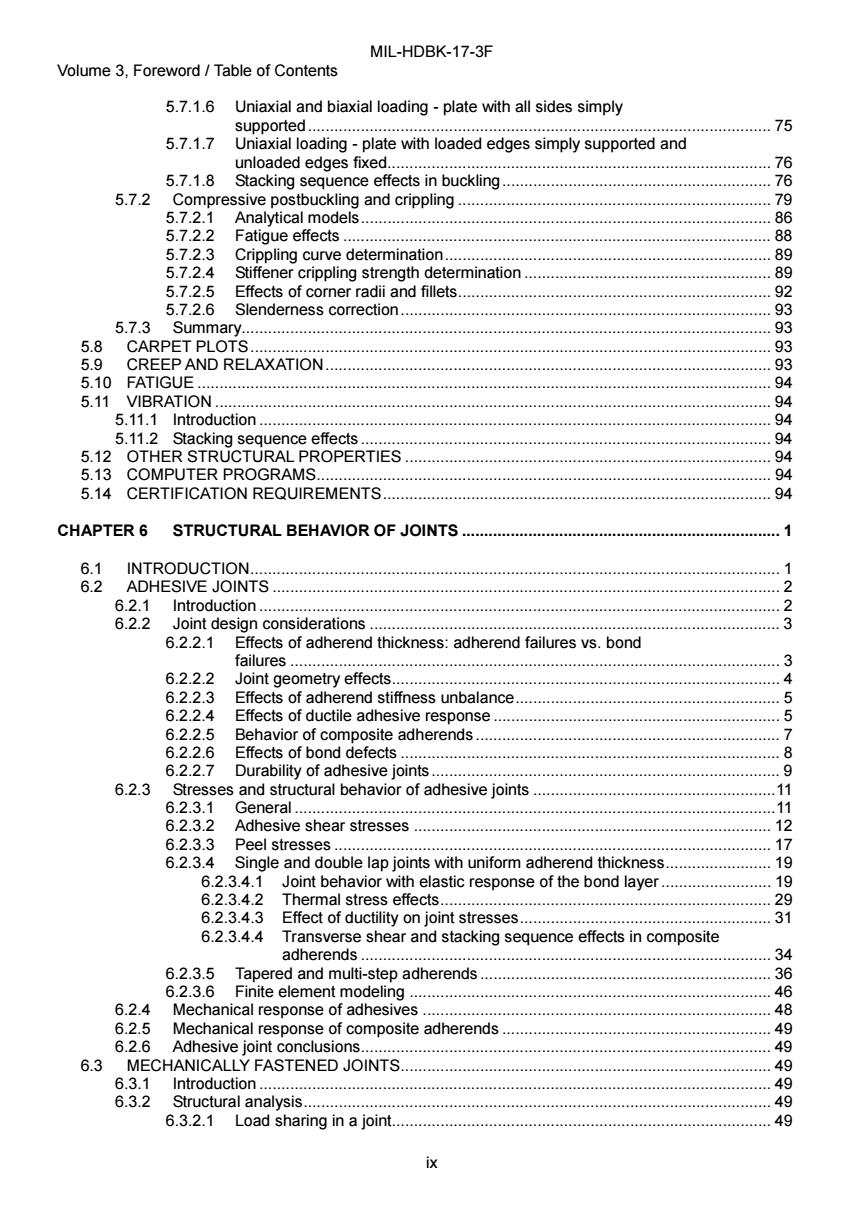
MIL-HDBK-17-3F Volume 3.Foreword Table of Contents 5.7.1.6 Uniaxial and biaxial loading-plate with all sides simply supported... ..75 5.7.1.7 Uniaxial loading-plate with loaded edges simply supported and unloaded edges fixed.... 76 5.7.18 Stacking sequence effects in buckling.............. 76 5.7.2 Compressive postbuckling and crippling.................79 5.7.2.1 Analytical models.................. 86 5.7.22 Fatigue effects.… 88 5.7.2.3 Crippling curve determination... 89 5.7.2.4 Stiffener crippling strength determination...89 5.7.2.5 Effects of corner radii and fillets...92 5.7.2.6 Slenderness correction..... 93 5.78 Summary 93 5.8 CARPET PLOTS... .93 5.9 CREEP AND RELAXATION.............. 93 5.10 FATIGUE… .94 5.11 VIBRATION.... 94 5.11.1 Introduction........... 94 5.11.2 Stacking sequence effects........ 5.12 OTHER STRUCTURAL PROPERTIES................ .94 ..94 5.13 COMPUTER PROGRAMS.............. .94 5.14 CERTIFICATION REQUIREMENTS .94 CHAPTER 6 STRUCTURAL BEHAVIOR OF JOINTS..... 1 6.1 INTRODUCTION... 1 6.2 HESIVE J○lNTS.a. 6.2.1 Introduction...... 6.2.2 Joint design considerations... 3 6.2.2.1 Effects of adherend thickness:adherend failures vs.bond failures..… .3 6.2.2.2 Joint geometry effects.4 6.2.2.3 Effects of adherend stiffness unbalance...... 5 6.2.2.4 Effects of ductile adhesive response................. 5 6.2.2.5 Behavior of composite adherends.................7. 6.2.2.6 Effects of bond defects... .8 6.2.2.7 Durability of adhesive joints.......... 9 6.2.3 Stresses and structural behavior of adhesive joints.... 6.2.3.1 11 Gener..4.....…...11 6.2.3.2 Adhesive shear stresses.12 6.2.3.3 Peel stresses... 17 6.2.3.4 Single and double lap joints with uniform adherend thickness........................ 9 6.2.3.4.1 Joint behavior with elastic response of the bond layer.......................... 19 6.2.3.4.2 Thermal stress effects...29 6.2.3.4.3 Effect of ductility on joint stresses.................. .31 6.2.3.4.4 Transverse shear and stacking sequence effects in composite adherends… 34 6.2.3.5 Tapered and multi-step adherends..36 6.2.3.6 Finite element modeling 46 6.2.4 Mechanical response of adhesives..... .48 6.2.5 Mechanical response of composite adherends.... 49 6.2.6 Adhesive joint conclusions..... 。4444444444444444 49 6.3 MECHANICALLY FASTENED JOINTS....49 6.3.1ntr0 duction................ 49 6.3.2 Structural analysis. 49 6.3.2.1 Load sharing in a joint.......... .49 ix
MIL-HDBK-17-3F Volume 3, Foreword / Table of Contents ix 5.7.1.6 Uniaxial and biaxial loading - plate with all sides simply supported......................................................................................................... 75 5.7.1.7 Uniaxial loading - plate with loaded edges simply supported and unloaded edges fixed....................................................................................... 76 5.7.1.8 Stacking sequence effects in buckling............................................................. 76 5.7.2 Compressive postbuckling and crippling ....................................................................... 79 5.7.2.1 Analytical models............................................................................................. 86 5.7.2.2 Fatigue effects ................................................................................................. 88 5.7.2.3 Crippling curve determination.......................................................................... 89 5.7.2.4 Stiffener crippling strength determination ........................................................ 89 5.7.2.5 Effects of corner radii and fillets....................................................................... 92 5.7.2.6 Slenderness correction.................................................................................... 93 5.7.3 Summary........................................................................................................................ 93 5.8 CARPET PLOTS...................................................................................................................... 93 5.9 CREEP AND RELAXATION..................................................................................................... 93 5.10 FATIGUE .................................................................................................................................. 94 5.11 VIBRATION .............................................................................................................................. 94 5.11.1 Introduction .................................................................................................................... 94 5.11.2 Stacking sequence effects ............................................................................................. 94 5.12 OTHER STRUCTURAL PROPERTIES ................................................................................... 94 5.13 COMPUTER PROGRAMS....................................................................................................... 94 5.14 CERTIFICATION REQUIREMENTS........................................................................................ 94 CHAPTER 6 STRUCTURAL BEHAVIOR OF JOINTS ........................................................................ 1 6.1 INTRODUCTION........................................................................................................................ 1 6.2 ADHESIVE JOINTS ................................................................................................................... 2 6.2.1 Introduction ...................................................................................................................... 2 6.2.2 Joint design considerations ............................................................................................. 3 6.2.2.1 Effects of adherend thickness: adherend failures vs. bond failures ............................................................................................................... 3 6.2.2.2 Joint geometry effects........................................................................................ 4 6.2.2.3 Effects of adherend stiffness unbalance............................................................ 5 6.2.2.4 Effects of ductile adhesive response ................................................................. 5 6.2.2.5 Behavior of composite adherends..................................................................... 7 6.2.2.6 Effects of bond defects ...................................................................................... 8 6.2.2.7 Durability of adhesive joints............................................................................... 9 6.2.3 Stresses and structural behavior of adhesive joints .......................................................11 6.2.3.1 General .............................................................................................................11 6.2.3.2 Adhesive shear stresses ................................................................................. 12 6.2.3.3 Peel stresses ................................................................................................... 17 6.2.3.4 Single and double lap joints with uniform adherend thickness........................ 19 6.2.3.4.1 Joint behavior with elastic response of the bond layer ......................... 19 6.2.3.4.2 Thermal stress effects........................................................................... 29 6.2.3.4.3 Effect of ductility on joint stresses......................................................... 31 6.2.3.4.4 Transverse shear and stacking sequence effects in composite adherends ............................................................................................. 34 6.2.3.5 Tapered and multi-step adherends.................................................................. 36 6.2.3.6 Finite element modeling .................................................................................. 46 6.2.4 Mechanical response of adhesives ............................................................................... 48 6.2.5 Mechanical response of composite adherends ............................................................. 49 6.2.6 Adhesive joint conclusions............................................................................................. 49 6.3 MECHANICALLY FASTENED JOINTS.................................................................................... 49 6.3.1 Introduction .................................................................................................................... 49 6.3.2 Structural analysis.......................................................................................................... 49 6.3.2.1 Load sharing in a joint...................................................................................... 49

MIL-HDBK-17-3F Volume 3.Foreword Table of Contents 6.3.2.2 Analysis of local failure in bolted joints... .51 6.3.2.3 Failure criteria.. 59 6.3.3 Design considerations....60 6.3.3.1 Geometry........ 60 6.3.3.2 Lay-up and stacking sequence............... 60 6.3.3.3 Fastener selection60 6.3.4 Fatigue...... 61 6.3.4.1 Influence of loading mode.62 6.3.4.2 Influence of joint geometry ..... 62 6.3.4.3 Influence of attachment details................................................................ 63 6.3.4.4 Influence of laminate lay-up....63 6.3.4.5 Influence of environment.... 3 6.3.4.6 Influence of specimen thickness.. 63 6.3.4.7 Residual strength............... 1163 6.8.5Test verification64 CHAPTER 7 DAMAGE RESISTANCE,DURABILITY,AND DAMAGE TOLERANCE. 1 7.1 OVERVIEW AND GENERAL GUIDELINES............1. ”S的 7.1.2 Composite-related issues. 7.1.3 General guidelines.2 7.1.4 Section organization.... 7.2 AIRCRAFT DAMAGE TOLERANCE.............. 4 4 7.2.1 Evolving military and civil aviation requirements..5 7.2.2 Methods of compliance to aviation regulations........... ....10 7.2.2.1 Compliance with static strength requirements (civil aviation)...........................11 7.2.2.2 Compliance with damage tolerance requirements(civil aviation) 12 7.2.2.3 Deterministic compliance method (civil aviation example).......... 15 7.2.2.4 Probabilistic or semi-probabilistic compliance methods(civil aviation))... ...19 7.2.2.5 Comparison of deterministic and probabilistic methods.................................24 7.2.2.6 Full-scale tests for proof of structure(civil aviation)..... 25 7.3 TYPES,CHARACTERISTICS,AND SOURCES OF DAMAGE..............................................26 7.3.1 Damages characterized by stage of occurrence............. 27 7.3.1.1 Manufacturing................. 27 7.3.1.2 ....0.0.........0......0..................................0........................................0.0.0 7.3.2 Damages characterized by physical imperfection............... 28 7.3.3 Realistic impact energy threats to aircraft...............................30 74 INSPECTION FOR DAMAGE33 7.4.1 Aircraft inspection programs.... 33 7.4.2 Recommendations for damage inspection data development ................................... 34 7.4.2.1G0als.… ,35 7.4.2.2 Inspection techniques.........35 75 DAMAGE RESISTANCE36 7.5.1 Influencing factors.... 36 7.5.1.1 Summary of results from previous impact studies.......................................37 7.5.1.2 Through-penetration impacts.38 7.5.1.3 Material type and form effects.41 7.5.1.4 Depth0 f damage… 43 7.5.1.5 Laminate thickness effects. 43 7.5.1.6 Structural size effects.. 46 7.5.1.7 Sandwich structure..48 7.5.2 Design issues and guidelines........ ,50 7.5.2.1 Use of impact surveys for establishing critical damages....................... 50 7.5.2.2 Structural arrangement and design details........ .50
MIL-HDBK-17-3F Volume 3, Foreword / Table of Contents x 6.3.2.2 Analysis of local failure in bolted joints............................................................ 51 6.3.2.3 Failure criteria .................................................................................................. 59 6.3.3 Design considerations ................................................................................................... 60 6.3.3.1 Geometry......................................................................................................... 60 6.3.3.2 Lay-up and stacking sequence........................................................................ 60 6.3.3.3 Fastener selection ........................................................................................... 60 6.3.4 Fatigue........................................................................................................................... 61 6.3.4.1 Influence of loading mode ............................................................................... 62 6.3.4.2 Influence of joint geometry .............................................................................. 62 6.3.4.3 Influence of attachment details........................................................................ 63 6.3.4.4 Influence of laminate lay-up............................................................................. 63 6.3.4.5 Influence of environment ................................................................................. 63 6.3.4.6 Influence of specimen thickness...................................................................... 63 6.3.4.7 Residual strength............................................................................................. 63 6.3.5 Test verification .............................................................................................................. 64 CHAPTER 7 DAMAGE RESISTANCE, DURABILITY, AND DAMAGE TOLERANCE....................... 1 7.1 OVERVIEW AND GENERAL GUIDELINES .............................................................................. 1 7.1.1 Principles ......................................................................................................................... 1 7.1.2 Composite-related issues ................................................................................................ 1 7.1.3 General guidelines........................................................................................................... 2 7.1.4 Section organization ........................................................................................................ 4 7.2 AIRCRAFT DAMAGE TOLERANCE.......................................................................................... 4 7.2.1 Evolving military and civil aviation requirements ............................................................. 5 7.2.2 Methods of compliance to aviation regulations.............................................................. 10 7.2.2.1 Compliance with static strength requirements (civil aviation)...........................11 7.2.2.2 Compliance with damage tolerance requirements (civil aviation) ................... 12 7.2.2.3 Deterministic compliance method (civil aviation example).............................. 15 7.2.2.4 Probabilistic or semi-probabilistic compliance methods (civil aviation) ........................................................................................................... 19 7.2.2.5 Comparison of deterministic and probabilistic methods .................................. 24 7.2.2.6 Full-scale tests for proof of structure (civil aviation) ........................................ 25 7.3 TYPES, CHARACTERISTICS, AND SOURCES OF DAMAGE .............................................. 26 7.3.1 Damages characterized by stage of occurrence ........................................................... 27 7.3.1.1 Manufacturing .................................................................................................. 27 7.3.1.2 Service............................................................................................................. 27 7.3.2 Damages characterized by physical imperfection ......................................................... 28 7.3.3 Realistic impact energy threats to aircraft...................................................................... 30 7.4 INSPECTION FOR DAMAGE.................................................................................................. 33 7.4.1 Aircraft inspection programs.......................................................................................... 33 7.4.2 Recommendations for damage inspection data development ...................................... 34 7.4.2.1 Goals ............................................................................................................... 35 7.4.2.2 Inspection techniques...................................................................................... 35 7.5 DAMAGE RESISTANCE.......................................................................................................... 36 7.5.1 Influencing factors.......................................................................................................... 36 7.5.1.1 Summary of results from previous impact studies........................................... 37 7.5.1.2 Through-penetration impacts........................................................................... 38 7.5.1.3 Material type and form effects ......................................................................... 41 7.5.1.4 Depth of damage ............................................................................................. 43 7.5.1.5 Laminate thickness effects .............................................................................. 43 7.5.1.6 Structural size effects....................................................................................... 46 7.5.1.7 Sandwich structure .......................................................................................... 48 7.5.2 Design issues and guidelines ........................................................................................ 50 7.5.2.1 Use of impact surveys for establishing critical damages................................. 50 7.5.2.2 Structural arrangement and design details...................................................... 50

MIL-HDBK-17-3F Volume 3.Foreword Table of Contents 7.5.2.3 Ground hail... ,51 7.5.2.4 Lightning......... 51 7.5.2.5 Handling and step loads.52 7.5.2.6 Exposed edges..... 52 7.5.3 Test issues.......... 52 7.5.4 Analysis methods-description and assessment....................................52 7.6 DURABILITY (DAMAGE INITIATION).............. 52 7.6.1 Introduction.… 52 7.6.2 Life factor approach........... 53 7.6.3 Load enhancement factor approach..........55 7.6.4 Ultimate strength approach. 56 7.6.5 Spectrum truncation....... 57 7.6.6 Durability certification.. 57 7.6.7 Influencing factors.. .57 7.6.8 Design issues and guidelines......................... 57 7.6.9 Test issues.… 58 7.6.10 Analysis methods-description and assessment.... 58 7.7 DAMAGE GROWTH UNDER CYCLIC LOADING............... 58 77.1 Influencing factors. 58 7.7.2 Design issues and guidelines.........60 773 TeSt SSUeS60 7.7.4 Analysis methods-description and assessment.. 60 7.7.4.1 Large through-penetration damage......... 60 7.7.4.2 Single delaminations and disbonds..... 60 7.7.4.2.1 Delamination growth ........... ..60 7.7.4.3 Impact damages. 60 7.7.4.4 Cuts and gouges...... 60 7.8 RESIDUAL STRENGTH............................ 61 7.8.1 Influencing Factors 61 7.8.1.1 Relationships between damage resistance and residual strength................. 61 7.8.1.2 Structure with impact damage...... 61 7.8.1.2.1 Material effects..... 61 7.8.1.2.2 Interlaminar toughness effects...62 7.8.1.2.3 Stacking sequence effects.62 7.8.1.2.4 Laminate thickness effects....... 4 7.8.1.2.5 Through-thickness stitching.. 64 7.8.1.2.6 Sandwich structure.64 7.8.1.2.7 Impact characteristic damage states.....................64 7.8.1.2.8 Residual strength -compressive/shear loads......................................68 7.8.1.2.9 Residual strength -tensile loads......... 69 7.8.1.2.10 Stiffened panels.. 69 7.8.1.3 Structure with through-penetration damage.................................71 7.8.1.3.1 Stitched skin/stiffener panels.....82 7.8.2 Design issues and guidelines...8 7.8.2.1 1Stacking sequences....................................................................82 7.8.2.2 Sandwich structure......................... 82 7.8.3 Test issues.... .83 7.8.3.1 Impact tests on coupons............. ..83 7.8.3.2 Impact tests on stiffened panels.83 7.8.3.3 Impact tests on sandwich panels.... ,83 7.8.3.4 Tests for large through-penetration damage to stiffened panels .....................84 7.8.3.5 Tests for large through-penetration damage to sandwich panels....................84 7.8.4 Analysis methods-description and assessment............. 4 7.8.4.1 Large through-penetration damage.......................84 7.8.4.1.1 Reduced singularity (Mar-Lin)model. 92 7.8.4.1.2 Strain softening laws..103 xi
MIL-HDBK-17-3F Volume 3, Foreword / Table of Contents xi 7.5.2.3 Ground hail ...................................................................................................... 51 7.5.2.4 Lightning .......................................................................................................... 51 7.5.2.5 Handling and step loads .................................................................................. 52 7.5.2.6 Exposed edges................................................................................................ 52 7.5.3 Test issues ..................................................................................................................... 52 7.5.4 Analysis methods - description and assessment........................................................... 52 7.6 DURABILITY (DAMAGE INITIATION) ..................................................................................... 52 7.6.1 Introduction .................................................................................................................... 52 7.6.2 Life factor approach ....................................................................................................... 53 7.6.3 Load enhancement factor approach.............................................................................. 55 7.6.4 Ultimate strength approach............................................................................................ 56 7.6.5 Spectrum truncation....................................................................................................... 57 7.6.6 Durability certification..................................................................................................... 57 7.6.7 Influencing factors.......................................................................................................... 57 7.6.8 Design issues and guidelines ........................................................................................ 57 7.6.9 Test issues ..................................................................................................................... 58 7.6.10 Analysis methods - description and assessment........................................................... 58 7.7 DAMAGE GROWTH UNDER CYCLIC LOADING................................................................... 58 7.7.1 Influencing factors.......................................................................................................... 58 7.7.2 Design issues and guidelines ........................................................................................ 60 7.7.3 Test issues ..................................................................................................................... 60 7.7.4 Analysis methods - description and assessment........................................................... 60 7.7.4.1 Large through-penetration damage................................................................. 60 7.7.4.2 Single delaminations and disbonds................................................................. 60 7.7.4.2.1 Delamination growth ............................................................................. 60 7.7.4.3 Impact damages .............................................................................................. 60 7.7.4.4 Cuts and gouges.............................................................................................. 60 7.8 RESIDUAL STRENGTH........................................................................................................... 61 7.8.1 Influencing Factors ........................................................................................................ 61 7.8.1.1 Relationships between damage resistance and residual strength .................. 61 7.8.1.2 Structure with impact damage ......................................................................... 61 7.8.1.2.1 Material effects...................................................................................... 61 7.8.1.2.2 Interlaminar toughness effects.............................................................. 62 7.8.1.2.3 Stacking sequence effects .................................................................... 62 7.8.1.2.4 Laminate thickness effects.................................................................... 64 7.8.1.2.5 Through-thickness stitching .................................................................. 64 7.8.1.2.6 Sandwich structure ............................................................................... 64 7.8.1.2.7 Impact characteristic damage states .................................................... 64 7.8.1.2.8 Residual strength - compressive/shear loads...................................... 68 7.8.1.2.9 Residual strength - tensile loads.......................................................... 69 7.8.1.2.10 Stiffened panels..................................................................................... 69 7.8.1.3 Structure with through-penetration damage .................................................... 71 7.8.1.3.1 Stitched skin/stiffener panels ................................................................ 82 7.8.2 Design issues and guidelines ........................................................................................ 82 7.8.2.1 Stacking sequences......................................................................................... 82 7.8.2.2 Sandwich structure .......................................................................................... 82 7.8.3 Test issues ..................................................................................................................... 83 7.8.3.1 Impact tests on coupons.................................................................................. 83 7.8.3.2 Impact tests on stiffened panels ...................................................................... 83 7.8.3.3 Impact tests on sandwich panels..................................................................... 83 7.8.3.4 Tests for large through-penetration damage to stiffened panels ..................... 84 7.8.3.5 Tests for large through-penetration damage to sandwich panels.................... 84 7.8.4 Analysis methods - description and assessment........................................................... 84 7.8.4.1 Large through-penetration damage................................................................. 84 7.8.4.1.1 Reduced singularity (Mar-Lin) model.................................................... 92 7.8.4.1.2 Strain softening laws ........................................................................... 103

MIL-HDBK-17-3F Volume 3.Foreword Table of Contents 7.8.4.1.3 LEFM-based methods. .109 7.8.4.1.4R-curves...... .110 7.8.4.2 Single delaminations and disbonds.......................113 7.8.4.2.1 Fracture mechanics approaches.. ..114 7.8.4.2.2 Sublaminate buckling methods114 7.8.4.3 Impact damages..115 7.8.4.3.1 Sublaminate buckling methods...... ..115 7.8.4.3.2 Strain softening methods...119 7.8.4.4 Cuts and gouges...... 121 79 APPLICATIONS/EXAMPLES.........121 7.9.1 Rotorcraft(Sik0rsky)).… 122 7.9.1.1 Damage .. 122 7.9.1.2 Environment. .122 7.9.1.3 Test loading conditions related to critical failure modes..............................122 7.9.1.4 Test loads-load enhancement factor (LEF)................................122 7.9.1.5 Spectrum - 7.9.1.6 Residual strength test.......... 124 7.9.2 Commercial aircraft (Boeing 777 empennage torque boxes)......................................1.24 7.9.2.1 Durability-environmental..124 7.9.2.2 Durability -mechanical loads..........125 7.9.2.3 7.9.2.4 Damage tolerance-"no growth"tests... 125 7.9.2.5 Damage tolerance-residual strength 127 7.9.2.6 Inspection plan....... ..127 7.9.3 General aviation (Raytheon Starship).............. 127 7.9.3.1 Introduction..127 7.9.3.2 Damage tolerance evaluation..... 128 7.9.3.2.1 Regulatory basis........... .128 7.9.3.2.2 Typical damage scenarios and related requirements..........................128 7.9.3.2.3 Damage source and modes..... 128 7.9.3.2.4 Element testing ...129 7.9.3.2.5 Test results..... .130 7.9.3.2.6 Full scale tests.… 134 7.9.3.2.7 Continued airworthiness inspections................... 135 7.9.3.3 Service experience 135 7.9.3.4 Conclusions.............. 136 7.9.4 Military aircraft...… .136 CHAPTER 8 SUPPORTABILITY 8.1 INTRODUCTION... 1 8.2 DESIGN FOR SUPPORTABILITY................... 8.2.1 In-service experience...................... 2 8.2.2 Inspectability... 8.2.2.1 General design guidelines................. 5 8.2.2.2 Accessibility for inspection..... 1 8.2.3 Material selection............. 8.2.3.1 Introduction.… > 8.2.3.2 Resins and fibers................... .7 8.2.3.3 8.2.3.4 Adhesives... 9 8.2.3.5 Supportability issues.. 9 8.2.3.6 Environmental concerns ............... i.9 8.2.4 Damage resistance,damage tolerance,and durability.......................................11 8.2.4.1 Damage resistance. 11 8.2.4.2 Damage tolerance.… 12 xii
MIL-HDBK-17-3F Volume 3, Foreword / Table of Contents xii 7.8.4.1.3 LEFM - based methods....................................................................... 109 7.8.4.1.4 R-curves...............................................................................................110 7.8.4.2 Single delaminations and disbonds................................................................113 7.8.4.2.1 Fracture mechanics approaches..........................................................114 7.8.4.2.2 Sublaminate buckling methods............................................................114 7.8.4.3 Impact damages .............................................................................................115 7.8.4.3.1 Sublaminate buckling methods............................................................115 7.8.4.3.2 Strain softening methods .....................................................................119 7.8.4.4 Cuts and gouges............................................................................................ 121 7.9 APPLICATIONS/EXAMPLES................................................................................................. 121 7.9.1 Rotorcraft (Sikorsky) .................................................................................................... 122 7.9.1.1 Damage ......................................................................................................... 122 7.9.1.2 Environment................................................................................................... 122 7.9.1.3 Test loading conditions related to critical failure modes ................................ 122 7.9.1.4 Test loads - load enhancement factor (LEF) ................................................. 122 7.9.1.5 Spectrum - truncation .................................................................................... 123 7.9.1.6 Residual strength test.................................................................................... 124 7.9.2 Commercial aircraft (Boeing 777 empennage torque boxes)...................................... 124 7.9.2.1 Durability - environmental.............................................................................. 124 7.9.2.2 Durability - mechanical loads......................................................................... 125 7.9.2.3 Damage ......................................................................................................... 125 7.9.2.4 Damage tolerance - "no growth" tests ........................................................... 125 7.9.2.5 Damage tolerance - residual strength ........................................................... 127 7.9.2.6 Inspection plan............................................................................................... 127 7.9.3 General aviation (Raytheon Starship).......................................................................... 127 7.9.3.1 Introduction .................................................................................................... 127 7.9.3.2 Damage tolerance evaluation........................................................................ 128 7.9.3.2.1 Regulatory basis ................................................................................. 128 7.9.3.2.2 Typical damage scenarios and related requirements ......................... 128 7.9.3.2.3 Damage source and modes................................................................ 128 7.9.3.2.4 Element testing ................................................................................... 129 7.9.3.2.5 Test results.......................................................................................... 130 7.9.3.2.6 Full scale tests .................................................................................... 134 7.9.3.2.7 Continued airworthiness inspections .................................................. 135 7.9.3.3 Service experience ........................................................................................ 135 7.9.3.4 Conclusions ................................................................................................... 136 7.9.4 Military aircraft.............................................................................................................. 136 CHAPTER 8 SUPPORTABILITY.......................................................................................................... 1 8.1 INTRODUCTION........................................................................................................................ 1 8.2 DESIGN FOR SUPPORTABILITY ............................................................................................. 2 8.2.1 In-service experience....................................................................................................... 2 8.2.2 Inspectability .................................................................................................................... 5 8.2.2.1 General design guidelines ................................................................................. 5 8.2.2.2 Accessibility for inspection................................................................................. 7 8.2.3 Material selection............................................................................................................. 7 8.2.3.1 Introduction ........................................................................................................ 7 8.2.3.2 Resins and fibers............................................................................................... 7 8.2.3.3 Product forms .................................................................................................... 9 8.2.3.4 Adhesives .......................................................................................................... 9 8.2.3.5 Supportability issues.......................................................................................... 9 8.2.3.6 Environmental concerns .................................................................................... 9 8.2.4 Damage resistance, damage tolerance, and durability ..................................................11 8.2.4.1 Damage resistance...........................................................................................11 8.2.4.2 Damage tolerance ........................................................................................... 12